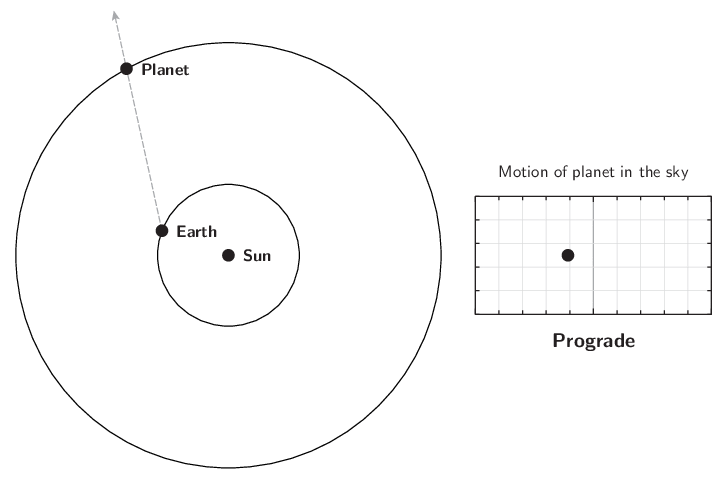Saturn will reach the end of its retrograde motion, ending its westward movement through the constellations and returning to more usual eastward motion instead. This reversal of direction is a phenomenon that all the solar system's outer planets periodically undergo, a few months after they pass opposition.
The retrograde motion is caused by the Earth's own motion around the Sun. As the Earth circles the Sun, our perspective changes, and this causes the apparent positions of objects to move from side-to-side in the sky with a one-year period. This nodding motion is super-imposed on the planet's long-term eastward motion through the constellations.
The diagram below illustrates this. The grey dashed arrow shows the Earth's sight-line to the planet, and the diagram on the right shows the planet's apparently movement across the sky as seen from the Earth:

The retrograde motion of a planet in the outer solar system.
Not drawn to scale.
Observing Saturn
Saturn leaves retrograde motion as its 2019 apparition comes to an end, although it will remain visible for some weeks in the dusk sky.
As retrograde motion ends, it will be visible in the evening sky, becoming accessible around 19:21 (PST), 32° above your southern horizon, as dusk fades to darkness. It will then reach its highest point in the sky at 20:00, 33° above your southern horizon. It will continue to be observable until around 23:56, when it sinks below 10° above your south-western horizon.
Over the following weeks, Saturn will reach its highest point in the sky four minutes earlier each night, gradually disappearing into evening twilight.
As it leaves retrograde motion, its celestial coordinates will be:
| Object | Right Ascension | Declination | Constellation | Magnitude | Angular Size |
| Saturn | 18h59m00s | 22°32'S | Sagittarius | 0.2 | 17.2" |
The coordinates above are given in J2000.0.
The sky on 18 Sep 2019
| The sky on 18 September 2019 | ||||||||||||||||||||||||||||||||||
|
80% 19 days old |
All times shown in PDT.
|
|||||||||||||||||||||||||||||||||
Source
The circumstances of this event were computed using the DE430 planetary ephemeris published by the Jet Propulsion Laboratory (JPL).
This event was automatically generated by searching the ephemeris for planetary alignments which are of interest to amateur astronomers, and the text above was generated based on an estimate of your location.
Related news
| 18 Sep 2019 | – Saturn ends retrograde motion |
| 10 May 2020 | – Saturn enters retrograde motion |
| 20 Jul 2020 | – Saturn at opposition |
| 28 Sep 2020 | – Saturn ends retrograde motion |
Image credit
© NASA/Cassini


